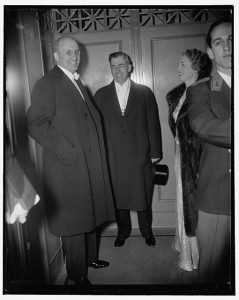On October 8 at 5:00 PM, Joyner Library is pleased to host our first CWIS guest speaker: Dr. Gregory S. Taylor. Dr. Taylor is Associate Professor of History at Chowan University in Murfreesboro, North Carolina. He is the author of The Life and Lies of Paul Crouch: Communist, Opportunist, Cold War Snitch (University Press of Florida, 2014) and of The History of the North Carolina Communist Party (University of South Carolina Press, 2009). Dr. Taylor’s talk is titled “Cold War Pawn: One Man’s Ideological Journey through a Divided World.” It will provide a fascinating look at one of the most controversial elements of early Cold War American politics, the former communist turned anti-communist informant, by examining the life of one North Carolina native. Please make plans to join us on Wednesday, October 8, at 5:00 PM, in the Faulkner Gallery on the second floor of Joyner Library, to hear Dr. Taylor.
The following is a guest post by Dr. Taylor previewing his presentation:
Nearly everyone is familiar with the global icons of the Cold War. Names like Stalin, Khrushchev, Castro, Mao, Eisenhower, Kennedy, Nixon, and McCarthy should be familiar to anyone with a sense of history. These men played leading roles during some of the tensest and most trying times in modern history. Whether we revere or revile them, they deserve their places in history.
But powerful political figures cannot act alone; even totalitarian leaders require supporters. One way politicians garner such support is through an ideology. By selling a worldview and convincing the masses of its righteousness, leaders can rally the masses by presenting any opposition as a threat. Even more useful is the creation of ideologues: true ideological believers whose single-minded perspective convinces them that their opponents are not simply wrong, but evil and worthy of destruction. Leaders on both sides of the Cold War used such ideologues for their own benefit. I call these figures the Cold War pawns.
Although such pawns were fundamental to the Cold War era, their tales are rarely told as historians tend to ignore them and focus on the elite. Some pawns, however, have broken through that historical resistance to have their stories told. Often this is the result of some fantastic event. Occasionally it is the result of their willingness to switch sides in the ideological struggle. People like Elizabeth Bentley, Louis Budenz, Whittaker Chambers, J.B. Matthews, and Harvey Matusow have gained such historical relevance for exactly that willingness. All five served first as Communists only later to turn on their former comrades to serve as anti-Communist informants.
There is one other figure, however, whose impact on the era and standing as a former Communist turned anti-Communist informant may dwarf even the historical significance of these five. His name is Paul Crouch. A North Carolina native, Crouch first came to fame in 1924 after being court-martialed for organizing a Communist group while serving in the U.S. military. After serving three years in Alcatraz for this “crime,” he spent the next seventeen years organizing for the Communist Party of the United States of America. During that time he studied in the Soviet Union, helped place Communists in the U.S. military, organized unions, oversaw strikes, created reams of propaganda, and attempted to spy on the Manhattan Project. In 1942 he was expelled from the Party when he raised concerns that it was more focused on propping up the Soviet Union and Party leaders than it was in pushing for a true Communist revolution.
Although disillusioned with Communism, Crouch found life on his own difficult and sought out a new ideological center. In 1949 he found it when he embarked on a career as an anti-Communist informant for the federal government. He named names, testified in countless trials, appeared before numerous Congressional hearings, reached out through every media array available, and generally played the part of the loyal anti-Communist. His efforts helped terrify the nation and propped up McCarthy’s claims that the nation was awash in Communists. In 1954, however, Crouch was exposed as a liar and was summarily dropped by the federal government. He died in 1955 a lonely and broken man, abandoned by both sides of the ideological struggle when his services no longer proved useful.
Crouch’s troubled life not only enables us to explore both sides of the Cold War-era ideological battle, it also allows us a unique opportunity to see the use and abuse of ideological pawns. The reality of such insights makes clear that both American and Soviet leaders acted in remarkably similar ways – they used a worldview to terrify their populace, gathered together true believers to push the cause, took advantage of both the fear and their supporters to increase their own power, and then dumped those individuals when they no longer served a purpose. Such a perspective may help explain our continuing fascination with the Cold War.
Join us at 5pm on Wednesday October 8 to learn more about Paul Crouch, to examine both sides of the Cold War ideological struggle, and to discuss the use and abuse of Cold War-era pawns.
Related Readings:
Budenz, Louis. This is My Story. New York: McGraw-Hill, 1947. (Joyner Hoover Collection: BX4668 .B72)
Chambers, Whittaker. Witness. New York: Random House, 1952. (Joyner Stacks: E743.5 .C47; second copy in Joyner Hoover: E743.5 .C47)
Kessler, Lauren. Clever Girl: Elizabeth Bentley, the Spy Who Ushered in the McCarthy Era. New York: Harper Collins, 2003. (Joyner Stacks: HX84.B384 K47 2003)
Lichtman, Robert M. and Ronald D. Cohen. Deadly Farce: Harvey Matusow and the Informer System in the McCarthy Era. Urbana: The University of Illinois Press, 2004. (Joyner Stacks: E743.5 .M36 L53 2004)
Taylor, Gregory S. The Life and Lies of Paul Crouch : Communist, Opportunist, Cold War Snitch. Gainesville, FL: University Press of Florida, 2014. (Joyner Stacks: E748.C949 T39 2014)

